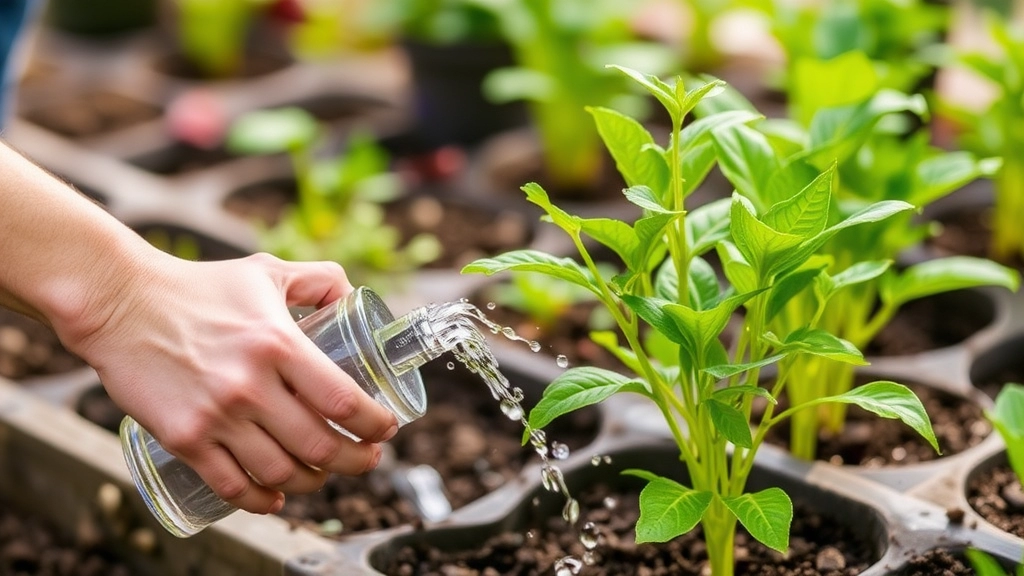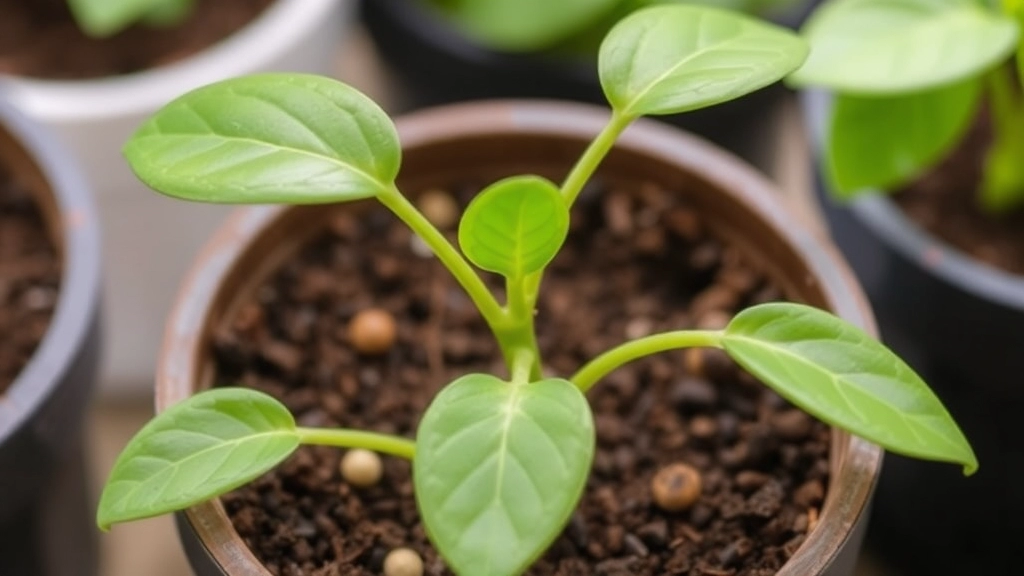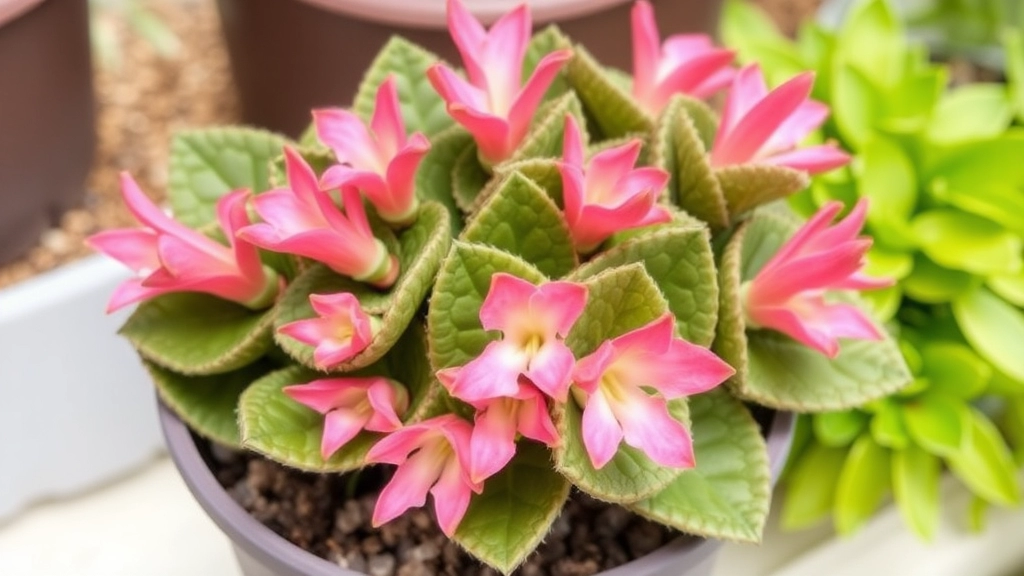Growing Kalanchoe Beharensis Cv Fang
When it comes to growing Kalanchoe Beharensis Cv Fang, the first thing you need to know is its optimal growing conditions. This unique succulent, also known as the “Felt Plant” or “Stalactite Plant,” thrives in well-draining soil and requires a good balance of sunlight and shade. Ensuring your plant receives the right amount of light and water is crucial for its health and longevity.
Watering Techniques
Watering techniques are equally important for the Kalanchoe Beharensis Cv Fang. Overwatering can lead to root rot, while underwatering can cause the plant to wilt. Aim to water your plant thoroughly but infrequently, allowing the soil to dry out between waterings. This approach mimics the plant’s natural habitat and promotes robust growth.
To ensure your Kalanchoe Beharensis âFang’ flourishes, it’s essential to create optimal growing conditions. This unique plant, known for its striking leaves and interesting texture, thrives in specific environments.
Key Factors for Optimal Growth
– **Light:**
– Kalanchoe Beharensis âFang’ prefers bright, indirect sunlight.
– A south-facing window is ideal, but avoid harsh afternoon sun to prevent leaf burn.
– **Temperature:**
– This succulent enjoys warm temperatures, ideally between 20°C to 30°C.
– Protect it from frost; temperatures below 10°C can be detrimental.
– **Humidity:**
– Low humidity is preferable.
– Avoid overly humid environments as this can lead to rot.
– **Air Circulation:**
– Good air circulation is crucial.
– Ensure your plant isn’t cramped in a tight space.
By meeting these conditions, you set your Kalanchoe Beharensis âFang’ up for success. For more detailed information, you can refer to the [complete care guide for Kalanchoe Blossfeldiana succulent](https://planthq.org/complete-care-guide-for-kalanchoe-blossfeldiana-succulent/) and learn about the [optimal care for Kalanchoe Blossfeldiana growth](https://planthq.org/optimal-care-for-kalanchoe-blossfeldiana-growth/).
II. Watering Techniques for Healthy Growth

So, you’ve got your Kalanchoe Beharensis ‘Fang’ all set up, but now you’re wondering about watering, right? It’s a common concern for many plant lovers. Too much or too little can really make or break your plant’s health.
Understanding Watering Needs
Kalanchoe Beharensis ‘Fang’ is a succulent, which means it likes things a bit on the dry side. Here are some key points to keep in mind:
- Check the Soil: Before you water, always poke your finger about an inch into the soil. If it feels dry, it’s time for a drink. If it’s still moist, hold off.
- Water Deeply: When you do water, give it a good soak. Let the water run through the drainage holes at the bottom of the pot. This encourages deep root growth.
- Frequency: In the growing season (spring and summer), you might water every 2-3 weeks. In winter, cut back to once a month or even less.
- Use Room Temperature Water: Cold water can shock the roots. Room temperature is best!
Signs Your Plant Needs Water
Sometimes, your plant will give you clues that it’s thirsty:
- Wrinkled Leaves: If the leaves start to look a bit shrivelled, it’s a sign it’s time to water.
- Droopy Stems: A droopy appearance can indicate dehydration.
Avoiding Overwatering
Overwatering is the enemy of succulents. Here’s how to avoid it:
- Use Well-Draining Soil: This is crucial. A mix specifically for succulents works wonders.
- Choose the Right Pot: Ensure your pot has drainage holes. This prevents water from sitting at the bottom.
- Adjust for Seasons: Remember, your plant needs less water in winter. Adjust your routine accordingly.
When it comes to nurturing Kalanchoe Beharensis âFang’, many plant enthusiasts often wonder: How much sunlight does it really need? What temperature is ideal for its growth?
### Sunlight Needs
Kalanchoe Beharensis âFang’ thrives best in bright, indirect sunlight. Here are some key points to consider:
– **Direct Sunlight**: While it can tolerate some direct sunlight, too much can lead to leaf burn. Aim for about 4-6 hours of indirect light daily.
– **Indoor Placement**: A south-facing window is ideal. If you notice the leaves stretching towards the light, it may be a sign that your plant needs more brightness.
– **Outdoor Care**: If you’re placing it outdoors, ensure it’s in a spot that receives dappled sunlight, especially during the hottest parts of the day.
### Temperature Preferences
Temperature plays a crucial role in the health of your Kalanchoe Beharensis âFang’. Here’s what to keep in mind:
– **Optimal Range**: This plant prefers temperatures between 18°C to 24°C (65°F to 75°F).
– **Cold Sensitivity**: Avoid exposing it to temperatures below 10°C (50°F). Cold drafts can cause stress and damage.
– **Humidity Levels**: Kalanchoe Beharensis âFang’ enjoys low humidity. If you live in a humid area, ensure good air circulation around the plant.
For more detailed information on caring for Kalanchoe Beharensis, you can refer to the [care and propagation guide](https://planthq.org/care-and-propagation-of-kalanchoe-beharensis-tree/).
Additionally, if you’re interested in other varieties, check out the [ultimate guide to Kalanchoe Blossfeldiana care](https://planthq.org/ultimate-guide-to-kalanchoe-blossfeldiana-hybrid-care/).
Soil and Potting Tips for Maximum Drainage

When it comes to cultivating Kalanchoe Beharensis ‘Fang’, one of the most pressing concerns is ensuring the right soil and potting conditions for optimal drainage. Poor drainage can lead to root rot, a common issue that many plant enthusiasts dread.
Choosing the Right Soil
For Kalanchoe Beharensis ‘Fang’, a well-draining soil mix is essential. Here are some options to consider:
- Cactus Mix: This is specifically designed for succulents and provides excellent drainage.
- DIY Mix: Combine regular potting soil with perlite or coarse sand in a 2:1 ratio. This helps improve aeration and drainage.
- Commercial Succulent Mix: These mixes are readily available and often contain the right balance of drainage and nutrients.
Pot Selection
The type of pot you choose can significantly impact drainage. Here are some tips:
- Drainage Holes: Always opt for pots with drainage holes to allow excess water to escape.
- Material Matters: Terracotta pots are a great choice as they are porous and help wick moisture away from the soil.
- Size Considerations: Choose a pot that is slightly larger than the root ball of your plant. This allows for growth without retaining too much moisture.
Potting Process
When potting your Kalanchoe Beharensis ‘Fang’, follow these steps:
- Prepare the Pot: Ensure it’s clean and has drainage holes.
- Layering: Place a layer of gravel or small stones at the bottom for extra drainage.
- Fill with Soil: Add your chosen soil mix, leaving enough space for the plant.
- Planting: Carefully place your Kalanchoe into the pot, ensuring the roots are well spread out.
- Top Up: Fill in around the roots with more soil, but avoid packing it down too tightly.
By prioritising soil and potting conditions, you can create an environment that encourages healthy growth for your Kalanchoe Beharensis ‘Fang’.
As we delve into the world of Kalanchoe Beharensis âFang’, it’s crucial to address a concern many plant enthusiasts face: pests.
### Identifying Common Pests
Kalanchoe plants can attract various pests that may hinder their growth. The most common culprits include:
– **Mealybugs**: These small, white, cotton-like insects often cluster in leaf joints and on stems.
– **Aphids**: Tiny, green or black insects that suck sap from the plant, causing leaves to curl.
– **Spider Mites**: These microscopic pests create fine webs on the leaves and cause stippling damage.
– **Scale Insects**: These pests appear as small, brown bumps on the leaves and stems.
### Prevention Strategies
Preventing pest infestations is always better than dealing with them later. Here are some effective strategies:
– **Regular Inspections**: Check your plant weekly for any signs of pests. Early detection is key.
– **Clean Leaves**: Wipe the leaves with a damp cloth to remove dust and potential pests.
– **Optimal Conditions**: Ensure your plant is in the right environment; healthy plants are less susceptible to pests.
### Treatment Options
If you do find pests, don’t panic. Here are some treatment options to consider:
– **Insecticidal Soap**: Spray this on affected areas to suffocate pests without harming the plant.
– **Neem Oil**: A natural pesticide that disrupts the life cycle of pests.
– **Manual Removal**: For larger infestations, you can remove pests by hand using a cotton swab dipped in alcohol.
For more detailed care tips, you might find our [care and propagation of Kalanchoe Beharensis tree](https://planthq.org/care-and-propagation-of-kalanchoe-beharensis-tree/) guide helpful. Additionally, ensuring your plant is in [optimal conditions](https://planthq.org/optimal-care-for-kalanchoe-blossfeldiana-growth/) can significantly reduce the risk of pest infestations.
Propagation Methods: Stems and Leaves

So, you’re keen to expand your Kalanchoe Beharensis ‘Fang’ collection?
Great choice! Propagation is a fun and rewarding way to grow your plant family.
Stems and Leaves: The Basics
You can propagate your Kalanchoe through both stem cuttings and leaf cuttings. Here’s how to do it:
Stem Cuttings
- Choose a Healthy Stem: Look for a plump, healthy stem with a few leaves.
- Cut It Right: Use clean, sharp scissors to cut a section about 4-6 inches long.
- Let It Callous: Place the cutting in a dry spot for a day or two. This helps it callous over, reducing the chance of rot.
- Plant It: Stick the cut end in well-draining soil. Water lightly.
- Keep It Warm: Place it in a warm, bright spot but out of direct sunlight.
Leaf Cuttings
- Pick a Leaf: Select a healthy, mature leaf.
- Cut Carefully: Snip it off at the base, ensuring you get a clean cut.
- Dry It Out: Let the leaf sit for a day to form a callous.
- Lay It Down: Place the leaf on top of the soil, or bury the base slightly.
- Water Sparingly: Mist occasionally, but don’t soak it.
Tips for Success
- Humidity: A little humidity can help the cuttings root faster. You can cover them loosely with a plastic bag to create a mini greenhouse effect.
- Patience is Key: It can take a few weeks for roots to develop, so don’t rush it.
As we continue discussing the care of Kalanchoe Beharensis âFang’, it’s crucial to address two common issues that can hinder its growth: overwatering and sunburn. These problems can easily arise if you’re not careful, and they can significantly impact the health of your plant.
### Overwatering
Overwatering is one of the most frequent mistakes made by plant owners. Kalanchoe Beharensis âFang’ is a succulent, which means it stores water in its leaves. Here’s how to avoid overwatering:
– **Check the Soil:** Always ensure the top inch of the soil is dry before watering.
– **Use Well-Draining Soil:** A cactus mix or a blend that includes perlite can improve drainage. For more tips on soil, you can refer to the [best soil for Kalanchoe Blossfeldiana](https://planthq.org/best-soil-for-kalanchoe-blossfeldiana-care-tips/).
– **Water Sparingly:** During the growing season (spring and summer), water every two to three weeks. In winter, reduce this to once a month.
### Sunburn
While Kalanchoe Beharensis âFang’ loves sunlight, too much direct exposure can lead to sunburn. This manifests as brown, crispy patches on the leaves. To prevent this:
– **Gradual Exposure:** If your plant is moving from indoors to outdoors, gradually introduce it to direct sunlight.
– **Monitor Light Conditions:** Ideally, aim for bright, indirect light. A south-facing window with filtered light works wonders. For additional lighting and care tips, see our guide on [fixing etiolated Kalanchoe Blossfeldiana](https://planthq.org/fixing-etiolated-kalanchoe-blossfeldiana-lighting-and-care-tips/).
– **Provide Shade:** During peak sun hours, consider providing some shade to protect your plant from intense rays.
By being mindful of these two issuesâoverwatering and sunburnâyou can ensure your Kalanchoe Beharensis âFang’ thrives beautifully.
FAQs about Kalanchoe Beharensis Cv Fang
What is Kalanchoe Beharensis ‘Fang’?
Kalanchoe Beharensis ‘Fang’ is a type of succulent known for its unique, fang-like protrusions on its leaves. It is a popular choice among plant enthusiasts due to its distinctive appearance and relatively low maintenance needs.
How often should I water my Kalanchoe Beharensis ‘Fang’?
During the growing season (spring and summer), water your Kalanchoe Beharensis ‘Fang’ every 2-3 weeks. In winter, reduce watering to once a month or even less. Always check the soil moisture before watering to avoid overwatering.
What type of soil is best for Kalanchoe Beharensis ‘Fang’?
A well-draining soil mix is essential for Kalanchoe Beharensis ‘Fang’. You can use a cactus mix, a commercial succulent mix, or a DIY mix of regular potting soil combined with perlite or coarse sand in a 2:1 ratio.
How do I know if my Kalanchoe Beharensis ‘Fang’ needs water?
Signs that your plant needs water include wrinkled leaves and droopy stems. Always check the soil moisture before watering to ensure it is dry.
What kind of pot should I use for Kalanchoe Beharensis ‘Fang’?
Choose a pot with drainage holes to allow excess water to escape. Terracotta pots are a good choice as they are porous and help wick moisture away from the soil. Ensure the pot is slightly larger than the root ball to allow for growth.
How can I propagate Kalanchoe Beharensis ‘Fang’?
You can propagate Kalanchoe Beharensis ‘Fang’ through stem cuttings or leaf cuttings. For stem cuttings, cut a healthy stem, let it callous, and then plant it in well-draining soil. For leaf cuttings, snip a mature leaf, let it callous, and lay it on top of the soil or bury the base slightly.
What are the signs of overwatering in Kalanchoe Beharensis ‘Fang’?
Signs of overwatering include yellowing leaves, a mushy stem, and root rot. To avoid overwatering, use well-draining soil, a pot with drainage holes, and adjust your watering routine based on the season.
Are there any special tips for potting Kalanchoe Beharensis ‘Fang’?
When potting, ensure the pot is clean and has drainage holes. Place a layer of gravel or small stones at the bottom for extra drainage, fill with well-draining soil, and carefully plant your Kalanchoe. Avoid packing the soil down too tightly.
What should I do if my Kalanchoe Beharensis ‘Fang’ is not growing well?
Check for proper watering, soil, and light conditions. Ensure the plant is not overwatered and that it is in well-draining soil. Make sure it is placed in a bright spot but out of direct sunlight. Adjust care routines based on the season.
Can I use cold water to water my Kalanchoe Beharensis ‘Fang’?
No, it’s best to use room temperature water. Cold water can shock the roots and potentially harm the plant.
References
-
How to Grow and Care for Kalanchoe Beharensis
-
Kalanchoe Plant Care Tips
-
Kalanchoe: How to Grow and Care for Kalanchoe Plants
